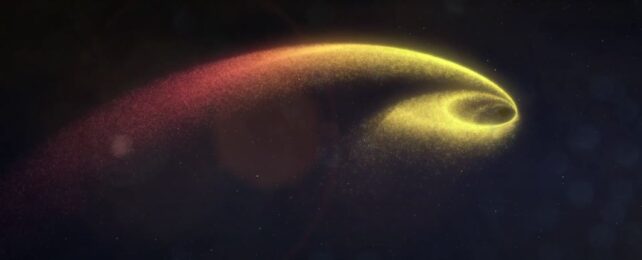A feast devoured by a supermassive black hole a billion light-years from Earth has revealed how fast that black hole spins on its axis.
Changes in the flare of light as the black hole woke up and fed were created by a disk of material that whirled and wobbled – and that wobble has given us the spin speed of the black hole at its center, say a team led by astrophysicist Dheeraj Pasham of the Massachusetts Institute of Technology (MIT).
It's the first time scientists have been able to calculate the spin speed of a black hole based on its wobbling accretion disk – giving us a new tool for understanding the strangest, densest known objects in the Universe.
How fast was it spinning? Less than 25 percent of the speed of light. That's pretty slow, for a black hole. By itself, it's not an amazingly useful number – but the implications of being able to find it at all are pretty exciting.
"By studying several systems in the coming years with this method," Pasham says, "astronomers can estimate the overall distribution of black hole spins and understand the longstanding question of how they evolve over time."
Supermassive black holes are the leviathans that lurk at the hearts of galaxies. Millions to billions of times the mass of the Sun, these massive objects are the gravitational hubs that help bind galaxies together, and play a significant role in their evolution. They also have a range of behaviors, from quiescent to brilliantly active, blazing across space-time with some of the brightest flares of light produced in the Universe.
That light is not produced by the black hole itself: their density is so high that the velocity required to escape their gravitational hold is higher than that of light in a vacuum. Rather, the light comes from the material that swirls around them as it feeds in: a thick torus that surrounds a disk that feeds into the black hole, like water going down a drain.
In 2020, astronomers caught sight of something intriguing. In a galaxy about a billion light-years away, a previously quiescent black hole suddenly produced a giant flare of light, named AT2020ocn. Data obtained from telescopes that homed in on that section of sky revealed that the most likely cause was a tidal disruption event – a rather sanitary name for the violent gravitational (tidal) evisceration (disruption) by a black hole of a passing star.
As the star is pulled apart, its dismembered guts form a white-hot disk around the star. And because the star can approach the black hole from any direction, that disk can be misaligned with the black hole's spin. This can create a wobble, or precession, as the black hole tugs it into alignment with its spin – a bit like an Euler's disk falling into position.
Because the wobble and the spin are linked, it was theorized that the former could be a way to measure the latter.
"But the key was to have the right observations," Pasham says. "The only way you can do this is, as soon as a tidal disruption event goes off, you need to get a telescope to look at this object continuously, for a very long time, so you can probe all kinds of timescales, from minutes to months."
We have instruments scanning the skies looking for things that suddenly brighten, so we managed to catch AT2020ocn early enough. Then, Pasham and his colleagues continued to observe and monitor the newly flaring galaxy, early enough in its outburst to catch the precession of the disk before it settled down.
They found that the galaxy flared in X-rays every 15 days or so for a little while, before subsiding, which they linked to the precession of the disk. When they combined this with the estimated mass of the black hole – around 2.5 million times the mass of the Sun – they were able to calculate how fast the black hole was spinning.
On its own, this data only tells us about one black hole, but it's the technique that is the really cool part. Tidal disruption events occur often enough that, should we be able to catch and monitor them with instruments such as the upcoming Rubin Observatory, we might be able to compile a distribution map of different spins that will enable us to learn more about how black holes behave and change over time.
"The spin of a supermassive black hole tells you about the history of that black hole," Pasham says. "Even if a small fraction of those that Rubin captures have this kind of signal, we now have a way to measure the spins of hundreds of TDEs. Then we could make a big statement about how black holes evolve over the age of the Universe."
The research has been published in Nature.
